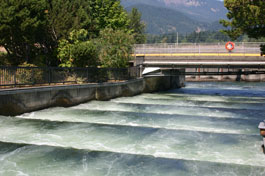Hydropower generators produce clean electricity, but hydropower does affect the environment
Most dams in the United States were built mainly for flood control, municipal water supply, and irrigation water. Although many of these dams have hydroelectric generators, only a small number of dams were built specifically for hydropower generation. Hydropower generators do not directly emit air pollutants. However, dams, reservoirs, and the operation of hydroelectric generators can affect the environment.
A dam that creates a reservoir (or a dam that diverts water to a run-of-river hydropower plant) may obstruct fish migration. A dam and reservoir can also change natural water temperatures, water chemistry, river flow characteristics, and silt loads. All of these changes can affect the ecology and the physical characteristics of the river. These changes may have negative effects on native plants and on animals in and around the river. Reservoirs may cover important natural areas, agricultural land, or archeological sites. A reservoir and the operation of the dam may also result in the relocation of people. The physical impacts of a dam and reservoir, the operation of the dam, and the use of the water can change the environment over a much larger area than the area a reservoir covers.
Manufacturing the concrete and steel in hydropower dams requires equipment that may produce emissions. If fossil fuels are the energy sources for making these materials, then the emissions from the equipment could be associated with the electricity that hydropower facilities generate. However, given the long operating lifetime of a hydropower plant (50 years to 100 years) these emissions are offset by the emissions-free hydroelectricity.
Greenhouse gases (GHG) such as carbon dioxide and methane form in natural aquatic systems and in human-made water storage reservoirs as a result of the aerobic and anaerobic decomposition of biomass in the water. The exact amounts of GHG that form in and are emitted from hydropower reservoirs is uncertain and depend on many site specific and regional factors.
Fish ladders help salmon reach their spawning grounds
Hydropower turbines kill and injure some of the fish that pass through the turbine. The U.S. Department of Energy has sponsored the research and development of turbines that could reduce fish deaths to lower than 2%, in comparison with fish kills of 5% to 10% for the best existing turbines.
Many species of fish, such as salmon and shad, swim up rivers and streams from the sea to reproduce in their spawning grounds in the beds of rivers and streams. Dams can block their way. Different approaches to fixing this problem include the construction of fish ladders and elevators that help fish move around or over dams to the spawning grounds upstream.
Last updated: November 7, 2022

